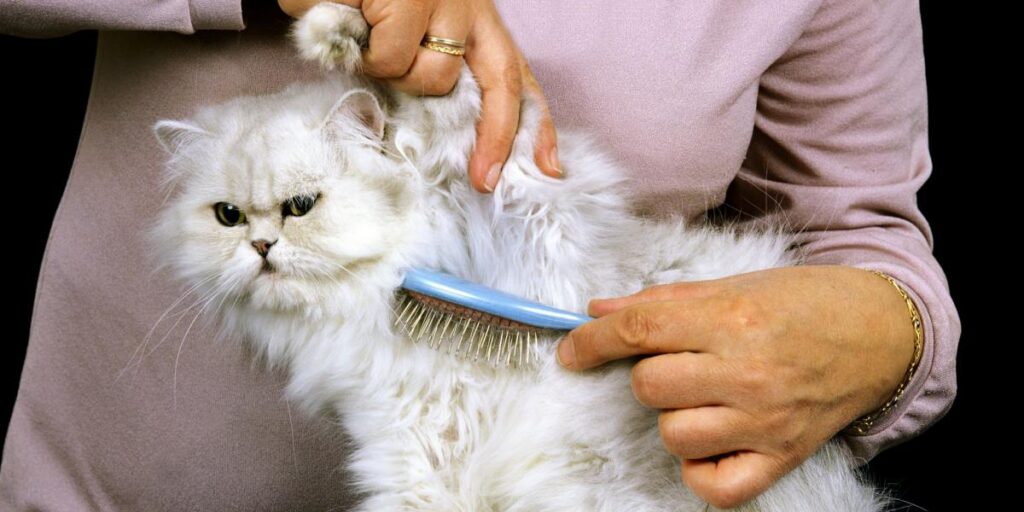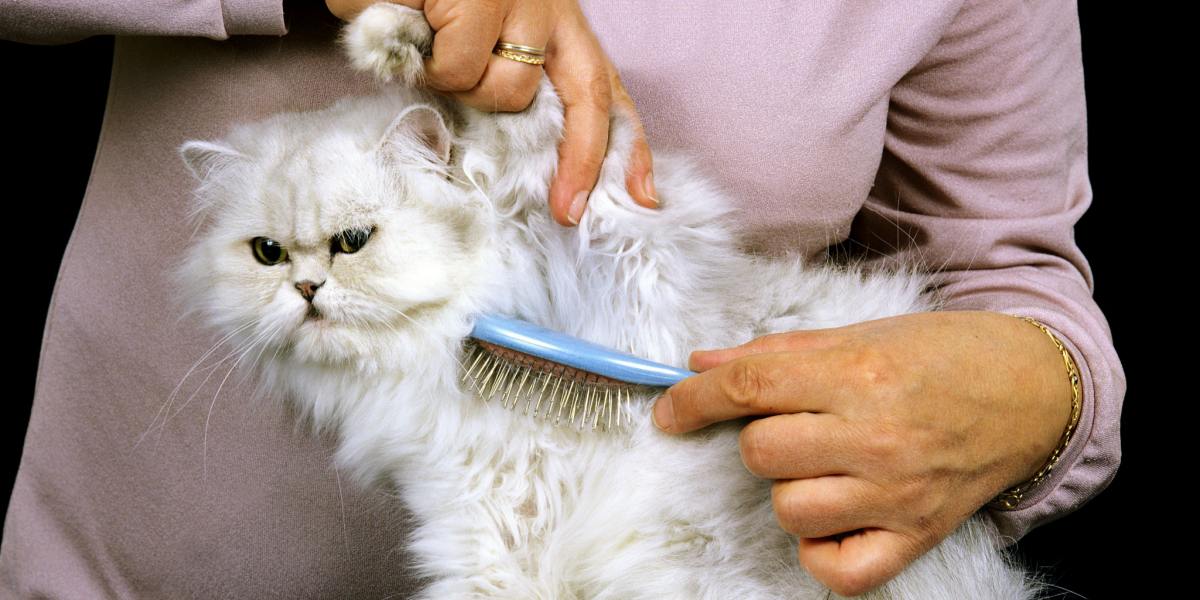Are you looking for reliable information on how to groom your Persian cat? Well, you’ve come to the right place! In this article, we’ll dive deep into the best methods of grooming a Persian cat, so you can keep your furry friend looking and feeling their best.
Grooming a Persian cat is essential for maintaining their beautiful long coat and preventing matting and skin issues. From brushing to bathing and everything in between, we’ll cover it all. We’ll also provide tips and tricks to make the grooming process a breeze for both you and your feline companion. So, whether you’re a new Persian cat owner or just looking to improve your grooming skills, stay tuned for some expert advice in our upcoming article. Trust me, you don’t want to miss this!

The Best Methods of Grooming a Persian Cat
Grooming is an essential aspect of caring for your Persian cat. Not only does it help maintain their beautiful coat, but it also ensures their overall health and well-being. In this article, we will discuss the importance of grooming, understand the Persian cat’s coat, choose the right grooming tools, establish a grooming routine, and provide a step-by-step guide to grooming your Persian cat. We will also cover brushing and detangling the coat, bathing and drying, trimming the nails, cleaning the ears, brushing the teeth, preventing matting and tangles, dealing with shedding, and the option of professional grooming services. So let’s dive in!
Importance of Grooming
Grooming plays a vital role in keeping your Persian cat healthy and happy. Regular grooming helps remove dirt, dander, loose hair, and parasites from their coat. It also improves blood circulation, reduces shedding, and prevents matting and tangles. Grooming sessions also provide an opportunity to bond with your cat and monitor their overall health. By grooming your Persian cat, you can ensure they remain clean, comfortable, and free from any discomfort or skin issues.
Understanding the Persian Cat’s Coat
The Persian cat is known for its luxurious and long coat. Their fur requires regular grooming to prevent it from becoming matted and tangled. Persian cats have a double coat consisting of a soft and dense undercoat and a long, silky topcoat. This combination makes their coat prone to matting and requires special attention during grooming. It is essential to understand the coat’s structure and take appropriate measures to maintain its health and beauty.
Choosing the Right Grooming Tools
Having the right grooming tools is crucial for effective grooming sessions. When it comes to grooming a Persian cat, various tools can come in handy. Here’s a list of essential grooming tools for your Persian cat:
- Wide-toothed metal comb: Ideal for removing loose hair and detangling the coat.
- Slicker brush: Helps remove knots, tangles, and dirt from the fur.
- Stainless steel grooming scissors: Used for trimming the fur around sensitive areas like the eyes, ears, and paws.
- Cat-specific shampoo and conditioner: Choose products specifically designed for cats to maintain the natural oils in their coat.
- Nail clippers: Used for trimming your cat’s nails to prevent them from becoming too long or sharp.
- Ear cleanser: Helps remove dirt and wax buildup from the ears.
- Cat toothbrush and toothpaste: Used to brush your cat’s teeth and promote dental hygiene.
Investing in high-quality grooming tools will ensure that you can groom your Persian cat effectively without causing any discomfort.
Establishing a Grooming Routine
Establishing a regular grooming routine is essential for maintaining your Persian cat’s coat and overall health. Start grooming your cat from an early age to get them accustomed to the process. Here’s a suggested grooming routine for your Persian cat:
- Daily brushing: Gently brush your cat’s coat daily to prevent matting and remove loose hair.
- Weekly bathing: Persians are known for their hygiene, but occasional baths are necessary. Use cat-specific shampoo and conditioner to keep their coat clean and silky.
- Regular nail trimming: Trim your cat’s nails every two to three weeks to prevent them from becoming too long or sharp.
- Monthly ear cleaning: Clean your cat’s ears using a cat-specific cleanser and cotton balls to remove wax and dirt.
- Regular teeth brushing: Brush your cat’s teeth at least two to three times a week using a cat toothbrush and toothpaste.
By following a consistent grooming routine, you can ensure that your Persian cat’s coat remains shiny, healthy, and tangle-free.
Step-by-Step Guide to Grooming a Persian Cat
Grooming a Persian cat requires patience, gentleness, and a step-by-step approach. Here’s a guide to help you effectively groom your Persian cat:
Brushing and Detangling the Coat
- Start by using a wide-toothed metal comb to remove any loose hair and detangle the coat gently.
- Follow up with a slicker brush to remove knots and tangles from the fur. Use slow, gentle strokes and be cautious around sensitive areas.
- Pay special attention to areas prone to matting, such as the armpits, belly, and behind the ears.
- If you encounter any stubborn mats, use your fingers or a mat splitter to carefully tease them apart.
Bathing and Drying the Persian Cat
- Before bathing, brush your cat’s coat to remove any loose hair and mats.
- Fill a sink or a bathtub with warm water that is neither too hot nor too cold.
- Wet your cat’s coat thoroughly, ensuring that the water reaches the undercoat.
- Use a cat-specific shampoo and gently massage it into your cat’s fur, avoiding the face and ears.
- Rinse your cat’s fur thoroughly to remove all traces of shampoo.
- Apply a cat-specific conditioner to maintain the coat’s shine and softness.
- Towel-dry your cat by gently patting them to absorb excess moisture.
- If your cat tolerates it, you can use a hairdryer on the lowest heat setting to finish drying their fur. Keep the dryer at a safe distance to avoid overheating or frightening your cat.
Trimming the Nails
- Use cat-specific nail clippers to trim your cat’s nails.
- Gently hold your cat’s paw, applying light pressure on the pad to extend the nails.
- Identify the clear section of the nail called the quick and avoid cutting into it.
- Trim the tip of each nail, taking care not to cut too close to the quick.
- If your cat becomes stressed or anxious during nail trimming, consider seeking professional help.
Cleaning the Ears
- Saturate a cotton ball with a cat-specific ear cleanser.
- Gently hold your cat’s earflap and insert the cotton ball, wiping the visible parts of the ear.
- Avoid going too deep into the ear canal and never use cotton swabs or any sharp objects.
- Repeat the process on the other ear, using a fresh cotton ball.
Brushing the Teeth
- Introduce your cat to toothbrushing gradually to ensure they are comfortable with the process.
- Use a cat-specific toothbrush and toothpaste formulated for feline dental hygiene.
- Apply a pea-sized amount of toothpaste to the brush and gently lift your cat’s lip to expose their teeth.
- Brush the teeth using small circular motions, paying attention to both the inner and outer surfaces.
- Gradually increase the brushing time as your cat becomes more accustomed to the routine.
Preventing Matting and Tangles
To prevent matting and tangles in your Persian cat’s coat, there are a few additional measures you can take:
- Regular brushing: Daily brushing helps remove loose hair and prevent mats from forming.
- Use detangling products: If your cat’s fur is prone to tangles, consider using detangling sprays or leave-in conditioners to make brushing easier.
- Trim long fur around sensitive areas: Keep the hair around the eyes, ears, and anus trimmed shorter to reduce the chances of matting in these areas.
Dealing with Shedding
Persians are known for their long fur, which tends to shed. To manage shedding, here are a few tips:
- Regular brushing: Brush your cat’s coat daily to remove loose hair and minimize shedding around the house.
- A healthy diet: Ensure your cat is receiving a balanced diet rich in nutrients, as a lack of nutrition can contribute to excessive shedding.
- Regular vet check-ups: Schedule regular visits to your veterinarian to rule out any underlying health issues that may cause excessive shedding.
Professional Grooming Services
While grooming your Persian cat at home is necessary, there may be instances where seeking professional grooming services becomes beneficial. Professional groomers are trained to handle the specific needs of Persian cats and can provide specialized care. Some reasons to consider professional grooming services include:
- Difficult or severe matting: If your cat’s coat has severe matting that you are unable to manage at home, a professional groomer can help remove them safely.
- Show preparation: Show-quality Persian cats require professional grooming before participating in cat shows to ensure their coat looks its best.
- Time constraints: If you lead a busy lifestyle and struggle to find time for regular grooming sessions, professional grooming services can provide the necessary care for your cat.
Conclusion
Grooming is an essential aspect of caring for your Persian cat’s health and appearance. Regular grooming sessions help maintain their beautiful coat, prevent matting, and ensure their overall well-being. By understanding the Persian cat’s coat, choosing the right grooming tools, and establishing a grooming routine, you can keep your furry friend looking and feeling their best. Remember to approach grooming with patience, gentleness, and love, creating a positive experience for both you and your Persian cat.
Questions and Answers:
- Q: How often should I groom my Persian cat? A: It is recommended to groom your Persian cat daily to prevent matting and tangles in their long coat.
- Q: Can I use human grooming products on my Persian cat? A: No, it is essential to use cat-specific grooming products as human products may contain ingredients harmful to cats.
- Q: Are Persian cats hypoallergenic? A: While no cat breed is completely hypoallergenic, Persian cats are known to produce fewer allergens compared to some other breeds.
- Q: Will regular grooming reduce shedding in my Persian cat? A: Yes, regular grooming, including brushing and bathing, can help minimize shedding by removing loose hair.
- Q: Can I groom my Persian cat myself, or should I seek professional help? A: You can groom your Persian cat at home with the right grooming tools and techniques. However, seeking professional help is beneficial in cases of severe matting or time constraints.
- Q: How do I introduce my Persian cat to grooming? A: Introduce grooming gradually by starting with short sessions and rewarding your cat with treats and praise. Make it a positive experience for them.
- Q: How often should I clean my Persian cat’s ears? A: It is recommended to clean your Persian cat’s ears once a month to remove dirt and wax buildup.
- Q: How can I prevent matting in my Persian cat’s fur? A: Regular brushing, using detangling products, and trimming hair around sensitive areas can help prevent matting in your Persian cat’s fur.
- Q: Should I bathe my Persian cat regularly? A: While Persian cats are generally clean, occasional baths are necessary to keep their coat clean and healthy. Aim for a bath every few weeks or when necessary.
- Q: Can I use a hairdryer to dry my cat’s fur after bathing? A: Yes, you can use a hairdryer on the lowest heat setting to dry your cat’s fur, but ensure that it is at a safe distance and your cat is comfortable with the process.
